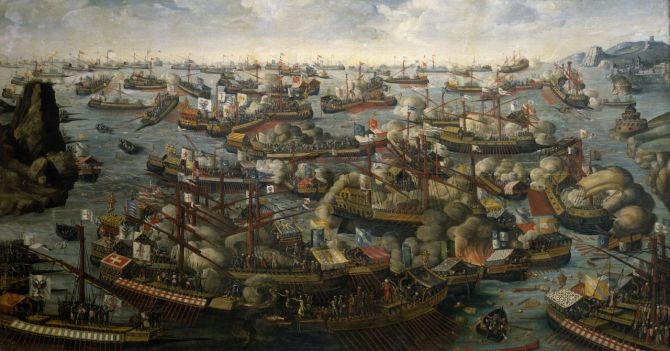viernes, 7 de septiembre de 1571
Batalla de Lepanto
Description The loss of Cyprus to the Turks in 1571 provoked action by the Christian league under Don Juan of Austria, the illegitimate half-brother of Philip II of Spain. A fleet of over 200 galleys proceeded to the Gulf of Lepanto (now Naupactos) where they met the Turkish fleet on 7 October 1571.
The galleys were mainly Venetian and Spanish but also included squadrons from the Papal States and Genoa. Although the Christians were outnumbered on the flanks they triumphed in the centre and the Turks were eventually defeated. The battle is memorable as the last of the great galley actions and for the large number of people who were killed; about 25,000 Turks and 8000 Christians.
The painting is an imaginative interpretation of the battle, with a high horizon and a sea littered with galleys locked in combat. A rocky coast is implied on the left, and land on the right, including the entrance to Lepanto. Smoke around the galleys indicates the ferocity of the battle at close quarters and inscriptions in Italian, some now fragmentary, identify a number of the participants.
In the left foreground is the galley of Gian' Andrea Doria (IL.GIO.ANDREA.DORIA), the commander of the Genoese squadron, together with the right wing of the Christian fleet. Immediately to his left with a large white cross on her stern awning is the flagship of the Genoese Negroni family (LA CAPITANIA DENEGRNI). The central galley these two are confronting is marked 'TRIPOLI' and may, from a fragmentary inscription toward the bow, be intended as the Barbary galliot of Piali Murad.
Immediately behind that, with a striped awning decorated with crescents, a galley marked 'CAVRALICO' is that of the corsair Caur Ali, with another corsair, Kara Hodja (CARACOZ), two beyond. Among the mass of galleys and galleasses behind are standards displaying the Lion of Venice, the red St George's cross of Genoa, and the gold and silver standards of the Papal States.
Don Juan's flagship is in the middle distance, left of centre, with its standard of Christ on the Cross and flying the Habsburg double-headed eagle, which also appears elsewhere. She is assisting a Venetian galley in attacking the flagship of Ali Pasha, the Turkish commander-in-chief, with the standard bearing the three crescents. Just to their right is the flagship of Marc'Antonio Colonna, who commanded the division from the Papal States. There are two galleasses on the right of the picture: their design was an attempt to combine a broadside of guns with oars. In the right foreground the galleys making off are those of the Turkish left wing, the closest bearing a long inscription identifying the Christian renegade, Uluch-Ali; OCHIALLRE.DALGIERIFUGE.DALLABATTA.GLIA. (Ochiali, King of Algiers flies from the battle).
The galley of Murat Reis flies a horizontal three-stripe ensign with a single crescent on the central bar directly above the stern of Uluch-Ali's. There is a woman in the stern of the Christian galley two up from the Negroni. She holds the head of a Turk in her right hand and the sword with which she removed it in her left. The painting appears to be based primarily on a Venetian print by Martin Rota, dated 1572, and there is a compositionally related painting by a different hand, and much more heavily inscribed, in the Museo Correr, Venice. The previous history of the NMM painting is not known, except that it was purchased in 1946 from a London dealer who may have obtained it from an English country house collection.
The prominence of the Negroni galley may indicate that family as original owners. The otherwise unknown artist has signed it 'HLETTER' (H and L joined) immediately after the inscription identifying Uluch-Ali. In 1960, Cecil Gould of the National Gallery, London, suggested 'Austro-Flemish school' as a possible association but no further information has yet been found.
The lower half of the canvas is re-used, transparency of the over-painting through age showing the underlying image of the upper half of an heraldic cartouche, with a fragmentary inscription and two male supporters, one bearing a trident and the other a sword.
Date made late 16th century
Artist/Maker unidentified artist
Materials oil on canvas
Measurements Painting: 1270 mm x 2324 mm; Frame: 1565 mm x 2620 mm x 90 mm; Weight: 85 kg

Fuentes
National Maritime Museum, Greenwich, London. Caird Fund
Noticia:
.
Fuentes
.
